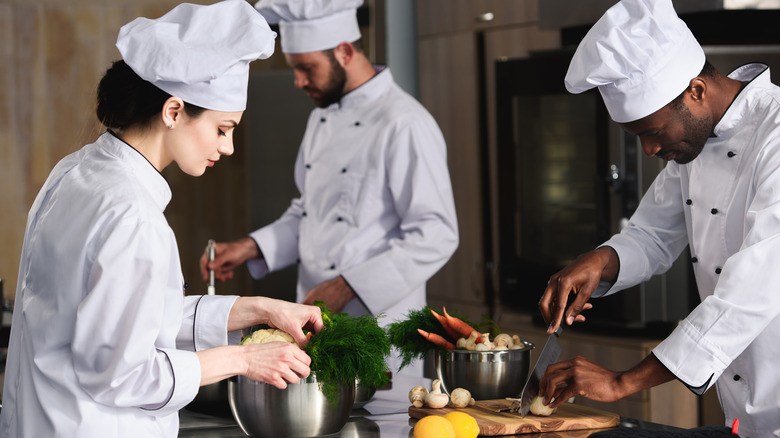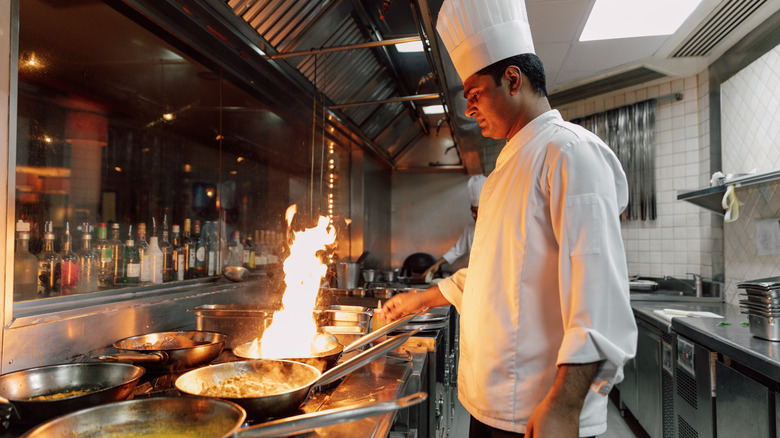What Are The Stations In A Traditional Kitchen Brigade?
If you're familiar with the culinary arts, you've probably heard about the kitchen brigade system. Originally developed by French chef and culinary icon, Georges-Auguste Escoffier, a kitchen brigade basically ensures that a busy commercial kitchen runs smoothly, with specific chefs doing specific jobs. Escoffier found that, without a strict system in place, a busy kitchen could easily turn into chaos. (Escoffier invented cherries jubilee in honor of Queen Victoria.) To get a clearer grasp of kitchen brigades, The Takeout spoke to Maricel Gentile, chef and owner of Maricel's Kitchen and author of "Maricel's Simply Asian Cookbook."
A classic French brigade includes an Executive Chef, Chef de Cuisine, Sous Chef, Sauté Chef, Grill Chef, Fry Chef, Garde Manger, and a Pastry Chef. "Each station is designed for flow, precision, and quality under pressure," Gentile told The Takeout. "Everyone has their lane so the line can run like a well-oiled machine."
The tasks of most of these chefs are pretty self-explanatory. For example, the Grill Chef handles any meat cooked over a grill while the Pastry Chef is in charge of bread and desserts. "The Executive Chef designs the menu, manages food cost, and leads the restaurant vision," Gentile said. "While the Chef de Cuisine runs daily operations, makes sure the team is executing with consistency, and leads the kitchen through service." The Sous Chef supports the Chef de Cuisine, manages prep and quality control, and steps in on the line whenever they're needed. Meanwhile, the Sauté Chef doesn't just sauté foods, but is also in charge of sauces, braising, and pan-seared dishes. The Garde Manger assembles salads and cold appetizers.
Not all restaurants can accommodate a full kitchen brigade
If you think this system and this number of chefs seems extreme, you're not completely wrong (especially for smaller establishments). When we asked about this, Gentile explained, "Many high-end and full-service restaurants still use a form of brigade, especially where volume and speed matter. In smaller or more casual spots, you might see cooks rotating across stations or working 'cook to order,' because the volume or menu scope makes a full brigade impractical." (As to those tall, white chef hats you may see in upscale eateries, they were developed by Escoffier's mentor, Marie-Antoine Careme.)
"In Asian kitchens, the structure is often more fluid and built around the wok station, which acts as the heart of the kitchen," Gentile explained. "At Maricel's Kitchen, for example, we don't always follow the traditional brigade because dishes often come from a single pan or station ... You'll still find a head chef (me), a sous, and cooks with different specializations, but roles tend to overlap more. Efficiency and multitasking are key."
The size of the kitchen obviously plays a huge role in whether a restaurant can handle a full kitchen brigade or not. Gentile pointed out the difference between, say, a tiny taqueria, which might have enough functional room for two cooks, versus a large steakhouse, which might be equipped for ten stations and ten different chefs. She pointed out that, ultimately, "You always tailor brigade to space, menu, and workflow." You can bring this same sense of organization to your home kitchen through mise en place.

